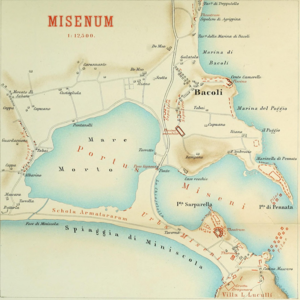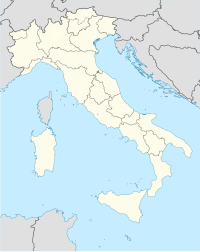Miseno
This articleneeds additional citations forverification.(January 2020) |
Misenois one of thefrazioniof themunicipalityofBacoliin theItalianProvince of Naples.Known in ancient Roman times asMisenum,it is the site of a great Roman port.
Geography
[edit]

Nearby Cape Miseno marks the northwestern end of theBay of Naples.
History
[edit]According to mythology, Misenum was named afterMisenus,a companion ofHectorand trumpeter toAeneas.Misenus is supposed to have drowned near here after atrumpetcompetition with the sea-godTriton,as recounted inVirgil'sAeneid.
With its gorgeous natural setting and the nearby important Roman cities ofPuteoliandNeapolis,Misenum became, from the Republican era, the site of Roman luxuryvillas,such as that ofMariuswhich was taken bySullaand later bought byLucullus.It was then appropriated as imperial property andTiberiusdied there in 37 AD.[1]
In 39 BC, Misenum was the site where the short-livedPact of Misenumwas made betweenOctavian(later Augustus), and his rivalSextus Pompeius.[2]
The first naval base,Portus Julius,nearby atPuteoli,was built during the civil wars in 36 BC byMarcus Agrippa,the right-hand man of theemperor Augustus.It was abandoned and a new base at Misenum developed into the largest Roman port for theClassis Misenensis,the most important fleet. It was a double harbour with two natural basins that exist today. The outer harbour was protected by two breakwaters marked from the south by a double row ofpilaein the sea running toward the projection opposite Punta Pennata and from the north by threepilaerunning south from the Punta Pennata. The inner harbour, the Mare Morto, to the west lies behind a spit of land, and may have been for the reserve fleet and for repair. A channel was cut through the spit to link the harbours.
The town became amunicipiumin the 1st century.
Pliny the Elderwas thepraefectin charge of the naval fleet at Misenum in AD 79, at the time of theeruption of Mount Vesuvius,visible to the south across the Bay of Naples. Seeing the beginnings of the eruption, Pliny left for a closer view and to effect a possible rescue, and was killed during the eruptions. The account of his death is given by his nephewPliny the Younger,who was also resident in Misenum at the time.
Monuments
[edit]

The ancient town including the naval barracks lies below the modern one and hence its layout is poorly understood. Most research has therefore been on the nearby coastal villas which included the fishponds, private harbours and docks inopus caementicium.[3]Nevertheless a rich resource of inscriptions documenting the population has been found particularly in the necropolis.
The Grotta Dragonara is a huge Roman cistern which was dug into the cliff next to the harbour. It may have been used as water supply for the fleet base and/or for the Villa of Lucullus, which was probably on the hill above.
A Roman theatre is located on the coast cut into the tuff cliffs with a semicircular gallery and is half submerged due tobradyseism.
Near the theatre on the coast a large Roman villa complex has recently been discovered which may have been the residence of Pliny the Elder, judging by its date and position giving maximum visibility of the port basin and the Gulf.[4]
The sacellum of the Augustales
[edit]Thesacellumof theAugustales[5]is also half submerged due to ground water.
It was discovered in 1968. It was a priestly college whose members were generally recruited among the freedmen in charge of the cult of the emperor Augustus and his successors. The architectural, sculptural and epigraphic finds range in date from the Domitian to theSeveranage.
A porticoed courtyard is in front of three rooms in the centre of which is the sacellum, a room with an apse in which an altar is reached by a marble flight of steps. Marble statues ofVespasianand his sonTituswere found here, now in the museum. A bronze equestrian statue of Vespasian's other son,Domitian,was also found in the left part of the sacellum, crushed under the collapse of rocks above. It had been transformed into his successorNervaafter thedamnatio memoriae(erasure of the records) as shown by a suture along the contour of the face and by three remnants of hair on the back originally depicting Domitian.[6]
A reconstruction of thetetrastylesacellum with surviving elements of the building is at the museum.[7]It has a façade more than 7 m high, made up of four columns ofcipollinomarble. It is topped by an elegant marble pediment at the centre of which, supported by two winged Victories, is a crown of oak leaves containing the portraits of the priest Lucius Lecanius Primitivus and his wife Cassia Vittoria and between them thepileus,typical priestly headgear.
Notable residents
[edit]In hisSecond Philipic,CiceromockedAntonyfor owning a property at Misenum (bequeathed to Antony byhis paternal grandfather), since it was shared with co-owners, having been mortgaged due to Antony's debts.[8][9]
The powerful and influential Roman empressAgrippina the Youngerlived in a palace here, once owned by the oratorHortensius(then by the emperors, and some three centuries later bySymmachus) in which she resided in the months before her death.[10]Misenum is also the place of death of EmperorTiberius.[11]
Misenum is said to be the birthplace ofSaint Sossius,adeaconwho was martyred withProculus of Pozzuoli.[citation needed]
In fiction
[edit]Misenum is one of the main settings inRobert Harris' novelPompeii,whose protagonist, Attilius, works as theaquariusat thePiscina Mirabilis(the reservoir to which theAqua Augustaaqueduct connected).
In the novelBen-Hur,Misenum is the location of a villa owned by Quintus Arrius later bequeathed to his adopted son Judah Ben-Hur. The Ben-Hur family would later live in Misenum.
References
[edit]- ^Tacitus Annals 6.50
- ^Plutarch Antonius 32-33
- ^Gervasio Illiano, Misenum: the Harbour and the City. Landscapes in Context Archeologia e Calcolatori 28.2, 2017, 379-389
- ^Remains of a monumental Roman villa linked to Pliny the Elder discovered at Misenohttps://archaeologymag /2024/01/roman-villa-linked-to-pliny-the-elder-miseno/
- ^Laird, M. (2015). Res communis Augustalium: Community in the Sacello degli Augustali at Misenum. In Civic Monuments and the Augustales in Roman Italy (pp. 139-182). Cambridge: Cambridge University Press. doi:10.1017/CBO9781139051767.006
- ^museo archeologico dei campi flegrei, catalogo generale, 3: liternum, Baia, Mlseno
- ^VISITA AL CASTELLO DI BAIAhttps:// ulixes.it/Visita-Castello-di-Baia.html
- ^Cicero Second Philippic XIX.47
- ^Cicero, Marcus Tullius (2018). Christopher Tanfield (ed.).Cicero Philippic II: A Selection Lines 44–50, 78–92, 100–119.London: Bloomsbury Academic. p. 36.ISBN978-1-350-01023-9.OCLC1012713230.
- ^Tacitus Annals 14.4
- ^Tacitus Annals 6.50
External links
[edit]- The Church of St. Sossio in Miseno(Archived2013-01-08 at theWayback Machine)




